Brussels, July 18,2025
Tobacco Europe takes note of the European Commission’s proposal to revise the Tobacco Excise Directive, published on 16 July 2025. TE welcomes the effort to create greater harmonisation across the EU, notably through the establishment of separate excise categories for electronic cigarettes, heated tobacco products, and tobacco-free nicotine pouches.
However, TE has serious concerns regarding the proposed minimum rates, which we believe are set too high for both combustible tobacco and newer nicotine products. The levels suggested go beyond what is justified by consumer income evolution and economic evidence, risking unintended consequences such as reduced excise revenue and increased illicit trade, particularly in lower-income Member States.
Importantly, an excessive increase to minimum rates applied to tobacco products will substantially compromise the tax rate setting sovereignty of national governments in most Member States. This will hinder those governments from pursuing the nuanced policies required to balance revenues with other political objectives and it will impose huge price shocks on millions of consumers in the EU.
TE urges EU policymakers to consider a more balanced approach that:
- Respects Member States’ ability to tailor excise rates to local economic conditions and purchasing power;
- Applies genuine purchasing power parity adjustments rather than arbitrary formulas;
- Adopts more moderate increases in minimum rates, aligned with inflation and income growth since the last Directive update;
- Focuses on monitoring flows of raw tobacco to fight fraud, on semi-processed tobacco.
Tobacco Europe stands ready to engage constructively in the legislative process and remains available to support EU institutions and Member States in ensuring a fair, effective, and economically sound excise framework.
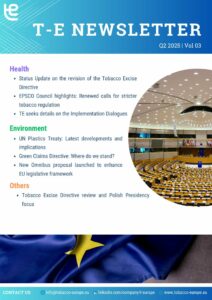
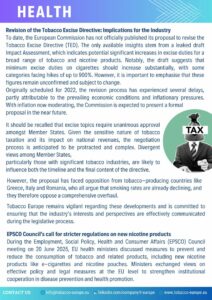
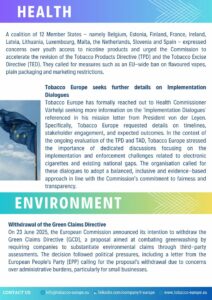
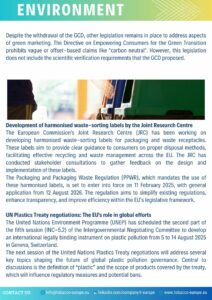
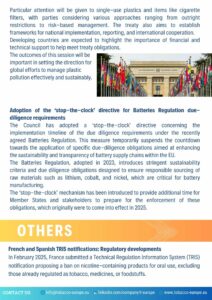
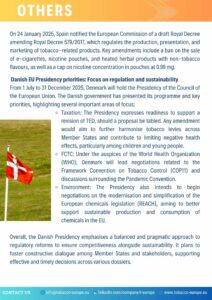
Brussels, 27 May 2025
Tobacco Europe has reached out to Commissioner Olivér Várhelyi to request further clarity on the upcoming Implementation Dialogues, as outlined in his mission letter from President von der Leyen.
These dialogues — set to take place at least twice a year — aim to ensure alignment between EU policy implementation and the realities experienced on the ground by stakeholders. The mission letter also refers to the preparation of an Annual Progress Report on Enforcement, highlighting the need for structured and inclusive stakeholder engagement.
Tobacco Europe would like to understand how the Commissioner intends to proceed with the organisation of these dialogues — including timelines, stakeholder engagement processes, and expected outcomes.
Please find the letter here Request from Tobacco Europe to Commissioner Varhelyi
Brussels, 19 May 2025
Tobacco Europe is increasingly alarmed about the growing number of dangerously misleading statements at EU level about vaping products. Most recently, during Monday 12 May’s exchange with the ENVI Committee, Commissioner Várhelyi stated that “vaping has created completely new health risks that are comparable or even bigger than smoking itself” and called for action “even beyond the Council recommendation”. This echoes earlier comments by Commissioner Hoekstra, who claimed that “vaping kills”.
Another worrying statement was made by Commissioner Várhelyi to the fact that vaping is causing ‘popcorn lung’. Importantly, Tobacco Europe would like to stress that popcorn lung risks are linked to unregulated, illicit products that may contain banned substances (such as diacetyl). Our members fully comply with EU and national safety standards, which notably prohibit such ingredients. In our views, effective enforcement is key to protecting public health – not prohibition. Tobacco Europe believes that such statements constitute dangerous misinformation that misleads EU citizens and potentially put lives at risk.
In addition, Tobacco Europe and its members share the justified concerns regarding underage people accessing all types of tobacco and nicotine products. It is not acceptable. While the issue needs to be dealt with urgently, as well as tackling the lack of enforcement, supporting the positive impact of alternatives for smokers is paramount. This requires better regulation backed by an overview of all science and data available.
These statements, alongside recent remarks made by the Belgian Health Minister and his cabinet – both in the press and during Council discussions – reinforce a troubling narrative. They also raise serious concerns about the direction of tobacco and nicotine policy discussions at a time when the European Commission is still conducting its evaluation of the Tobacco Products Directive. Tobacco Europe contends that such statements, lacking proper science-based justification, will undermine the Commission’s attempts to achieve “better regulation” as they are ungrounded in evidence and do not reflect industry realities.
Importantly, the companies we represent manufacture and market only products that fully comply with all applicable rules. The presence of non-compliant products in the Belgian market in no way reflects the responsible approach of our members, who strictly adhere to the rules in place.
The presence in Belgium of non-compliant products is a matter of enforcement by the authorities. It is their responsibility to ensure that rules are properly implemented and that illicit products are removed from the market.
The statements only reinforce what Tobacco Europe has long argued: Prohibitionist approaches are counterproductive. Bans and overly restrictive measures, such as Belgium’s ban of nicotine pouches and disposable electronic cigarettes, do not eliminate demand – they simply shift it to unregulated and illicit channels, undermining public health objectives, aggravating enforcement challenges, and resulting in state revenue losses.
The European Commission is running an evaluation of the Tobacco Products Directive. The steps taken afterwards should be based on robust evidence and in full consultation with the co-legislators, industry, and civil stakeholders. Premature and inflammatory political statements risk pre-empting this process and diminishing its credibility. Having acknowledged that their own initiatives have yet to deliver, we trust policymakers will honour – and not pre-empt – the integrity of the legislative process.
We welcome dialogue with national authorities. The persistence of illicit products is not only due to enforcement gaps but also to the exclusion of compliant industry stakeholders from regulatory discussions. This exclusion prevents policymakers from benefiting from our sector’s expertise, technical insight, and practical experience in building effective, enforceable solutions. Tobacco Europe´s members’ commitments go further than what is legally required, following a strict Code of Conduct that includes additional safeguards and responsible marketing practices to ensure products are sold and used appropriately.
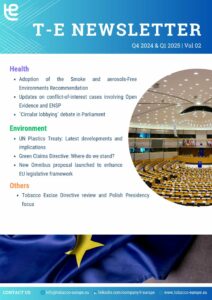
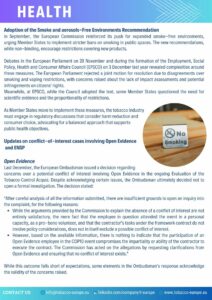
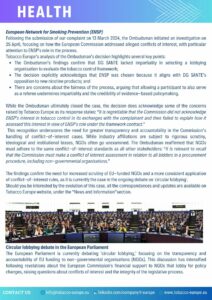
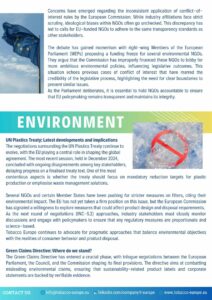
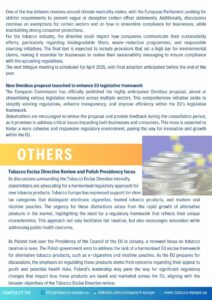
Tobacco Europe is thrilled to invite you to our hybrid session “Eyes on Brussels”* at EVO NXT on Friday 4 April between 12:00 and 12:30.
Our association represents the leading tobacco and nicotine products manufacturers within the EU. During this interactive session, we will provide an update on the latest key policy developments in Brussels and across the EU, and their impact on the tobacco and nicotine industry.
Our presentation will tackle the most relevant regulatory discussions. Join us to learn how the latest updates from Brussels and the wider European landscape may influence our industry and engage in a discussion on what’s next for stakeholders.
Tobacco Europe is thrilled to be part of this edition of Evo Nxt, an insightful innovative business fair, during which the major industry associations will provide visitors with the latest insights. Listen to representatives from the Independent European Vape Alliance (IEVA), the UK Vaping Industry Association (UKVIA), the Alliance for Tobacco-Free Enjoyment (BfTG), the German Tobacco and Novel Products Association (BVTE), the European Confederation of Tobacco Retailers (C. E.D.T.), the Nordic Nicotine Pouches Alliance (NNPA.EU), the European Cannabis Association (ECA) and the Electronic Cigarette Professional Committee of the China Electronics Chamber of Commerce (ECCC).
>>> The entire EVO NXT programme is available here.
>>> Tickets for EVO NXT are available in the online shop.
* The Eyes on Brussels is a live platform for information that exists for 2 years now.
Once a month, on a Friday and from 12:00 to 12:30, Tobacco Europe convenes a 30 minute live online session to provide participants with the latest updates on policies and regulations impacting the industry at the EU level.
Typically, we cover topics such as the revisions of the Tobacco Products Directive and the Tobacco Excise Directive, but also impacting milestones such as COP and MOP, which are directly related to our industry.
Brussels, February 6
Following Tobacco Europe’s complaint lodged in March 2024, the Ombudsman has finally issued a decision on the 4th of February and informed us that they were closing the inquiry as the “the Ombudsman found that no further inquiries are justified in this case”.
While deciding that there is no cause for a financial conflict of interest, the Ombudsman’s findings confirm what Tobacco Europe has long argued: the Commission failed to acknowledge ENSP’s vested interests and concealed the bias in the legislative process involving the Tobacco Products Directive currently under evaluation.
The Ombudsman herself stated:
“It is regrettable that the Commission did not acknowledge ENSP’s interest in tobacco control in its exchanges with the complainant and then failed to explain how it assessed this interest in view of the ENSP’s role under the framework contract.”
This case highlights a deeper issue: the Commission’s selective interpretation of conflict-of-interest rules. While industry links are heavily scrutinized, ideological and institutional biases within NGOs remain unchecked. To the point where the Ombudsman reminds the Commission NGOs must be subject to the same conflict of interest standards:
“It is relevant to recall that the Commission must make a conflict of interest assessment in relation to all bidders in a procurement procedure, including non-governmental organisations” (emphasis added).
The Ombudsman’s decision serves as a wake-up call—EU-funded NGOs must be subject to the same transparency and accountability standards as all other stakeholders.
Find attached to this article the decision of the Ombudsman, and Tobacco Europe’s reactive statement to it.
TE Reactive Statement Ombudsman_ENSP_OE Final clean 05 02
DECISION_202400517_20250204_104705
Brussels, December 3rd, 2024
Today, the EPSCO Council adopted the Smoke and Aerosols Free Environments Recommendation.
Tobacco Europe regrets the Council’s decision to include emerging products within the scope of this Recommendation. This inclusion, in our view, lacks a solid scientific foundation and fails to account for the specificities of these products.
Moreover, we find the extension of restrictions to open and semi-open spaces, such as hospitality terraces, to be disproportionate and unsupported by evidence of public harm.
It is important to remember that this Recommendation remains non-binding for Member States, allowing each to determine the measures best suited to their national contexts.
We encourage policymakers to continue engaging in a balanced dialogue and to base their decisions on thorough scientific analysis and proportionality.
Brussels, November 11, 2024
End of October, Tobacco Europe wrote to Mrs Juhansone, Secretary General, to ask whether the ongoing evaluation of the Tobacco Control Acquis, including the Tobacco Products Directive (TPD) and the Tobacco Advertising Directive (TAD), had been selected among the evaluations to be scrutinised by the Regulatory Scrutiny Board (RSB) this year or in 2025.
In her answer from November 29, Mrs Juhansone confirmed that the Evaluation of the legislative framework for tobacco control has been selected for scrutiny in 2025. Tobacco Europe welcomes such confirmation and hope this will ensure the quality of the evaluation and the soundness of any regulatory decisions stemming from it.
Find the full document here: SG response Tobacco Europe letter fin
Find Tobacco Europe’s letter here: Tobacco Europe letter to Secretary General on Evaluations
Brussels, October 14 2024
Tobacco Europe wrote this day to the Ombudsman to draw attention on a potential conflict of interest that involves Open Evidence, the leading party in the consortium contracted by the European Commission for services concerning EU actions in tobacco control, including the ongoing revision of the Tobacco control acquis.
This letter follows TE’s previous correspondence shared with the Ombudsman on 13th March, which already highlighted our concerns regarding both Open Evidence and ENSP (under investigation).
As detailed in the attached letter, Tobacco Europe and its members are worried about potential breaches of confidentiality, professional misconduct, and conflicts of interest, which could compromise the impartiality and objectivity required for the contractual work. This is why we urge the Ombudsman to thoroughly investigate these concerns and take appropriate actions towards the Commission to ensure the integrity and impartiality of the contracted work and that the proper measures are put in place to prevent such misconducts.
The full document can be found here: Tobacco Europe letter to the Ombudsman on Open Evidence 14.10.24
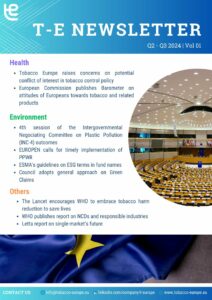
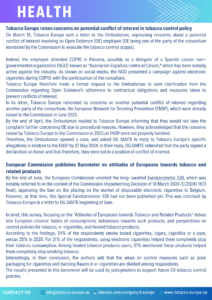
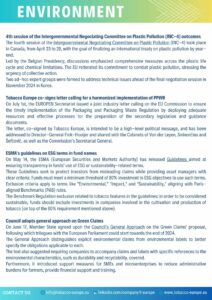
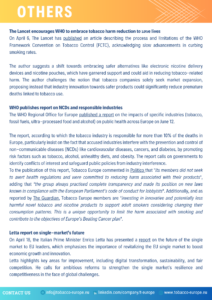
Brussels, 20 September 2024
Tobacco Europe thanks the Ombudsman’s inquiry team for the diligent work carried out regarding the potential conflict of interest with ENSP in the framework contract on tobacco control policy, and welcomes the opportunity to provide comments to the Report on the meeting of the European Ombudsman inquiry team with representatives of the European Commission on how it handled these alleged conflicts.
All comments provided by Tobacco Europe can be found in the document here: Tobacco Europe’s comments to Ombudsman Report meeting 20.09.24
Brussels, 17 September 2024
Download the statement here: 24.09.17 Tobacco Europe’s statement to the Publication of the Smoke- and Aerosol-Free Environments’ recommendation
On September 17, the outgoing Commission put forward a proposal for the revision of the non-legislative Council Recommendation on Smoke-Free Environments, just days after publishing the ‘Draghi’ Report to revamp European competitiveness.
Tobacco Europe considers that the inclusion of emerging products within the scope of the Recommendation lacks scientific basis and views the extension to open and semi-open areas (such as hospitality terraces) as disproportionate.
Tobacco Europe wrote to the Commission expressing concerns about the process. No evaluation was performed in line with the Better Regulation guidelines. No new impact assessment was conducted relying instead on the 2008 one, which did not cover emerging products and focused only on indoor spaces.
Additionally, the Commission had committed to publishing a ‘synopsis report’ summarizing stakeholders input at the conclusion of the consultation. Instead, it released the report simultaneously with the proposal denying us and +200 stakeholders the opportunity to assess how the input was considered ahead of the proposal.
Tobacco Europe wished the outgoing Commission had acted in transparency and in accordance with the principles of Better Regulations.
Brussels, 10 September 2024
Download the letter here: TE letter on SfE to Commissioner Schinas 10.09.24
Tobacco Europe wrote to Commissioner Schinas regarding the revision of the Recommendation on Smoke-free Environments. Indeed, as the proposal may be addressed on the 17th of September, Tobacco Europe would like to bring the Commissioner’s attention to several important elements highlighted in the letter attached, and below:
Dear Commissioner Margaritis Schinas,
Tobacco Europe has been following the ongoing discussions regarding the revision of the Recommendation on Smoke-free Environments. We understand it may be addressed on the 17th of September, and we greatly appreciate the chance to engage with you on this topic.
While we assume the publication of a proposal will not be on the agenda due to the ongoing consultation process, we would like to seek your clarity. As you may be aware, the Commission had committed to publishing a ‘synopsis report’ summarizing the input from stakeholders at the conclusion of the consultation. However, to date, this report remains unpublished and thus we are led to assume the consultation is still ongoing:
At the end of the consultation process, a synopsis report summarising all consultation activities will be published.
We believe the timely publication of the report, well in advance of any proposal and in line with the process the Commission outlined to stakeholders, is crucial for transparency and ensuring the input of over 200 entities, including the Tobacco Europe members, is adequately considered. If there is intention to withhold it, we would greatly appreciate your help in reconsidering this, in the spirit of openness the Commission champions and its duty to justify such decisions.
We also trust you agree public scrutiny is essential. Without an evaluation or impact assessment performed, the consultation is the main source of primary and timely data for this revision. Unfortunately, some studies the Commission relies on are outdated (some of which date from the 1990s!), which raises concerns about the evidence-base related to today (please see the Annex our remarks on the revision process).
We are aware DG SANTE is navigating complex challenges, including the management and verification of conflict-of-interest allegations involving the contractor supporting this revision consultation. As stakeholders, we are not privy to this process, but we trust your experience and help to ensure it proceeds with the integrity expected by all parties.
Particularly, we would appreciate your consideration of whether it aligns with the principles of Better Regulation to base policy decisions on deliverables authored by contractors subject to unresolved conflict of interest allegations. Unfortunately, it is unclear to us whether due diligence and thorough reviews were conducted on those deliverables. Furthermore, the Commission previously mentioned the need for “further work” and additional “evidence gathering.” We are left uncertain whether those observations, or the delay in the publication of the consultation report, are linked to the conflict-of-interest concerns in any way.
In the UK, similar discussions have sparked significant public debate, which we believe serves as a valuable lesson. We hope the Commission will rely on comprehensive, transparent, and up-to-date data to base any decisions.
Tobacco Europe members remain fully committed to participating in the consultation process. With the publication of the ‘Draghi report’ emphasizing the regulatory burden of businesses and the definition of Commissioner portfolios, we believe that crucial aspects, such as competitiveness, which were not sufficiently addressed in previous questionnaires, should now be given proper attention.
Thank you very much for your attention to these matters,
Yours Sincerely,
Nathalie Darge
ANNEX – General comments on the process
It is unclear whether an evaluation of the revised Recommendation was ever performed in line with the Commission’s Better Regulation guidelines. A formal evaluation should have been made but to our knowledge, it seems the Commission limited itself to Implementation Reports.
The Commission developed the 2021 Rand report based on both a questionnaire and desktop research on the implementation of the 2009 Council Recommendation on smoke-free environments.
This report was meant to be the basis in 2022 for a Commission proposal in 2023.
The Commission is considering the 2021 RAND report on the Tobacco Advertising Directive and Smokefree environments as an “evaluative study”. However, this report does not follow the evaluation structure imposed by the Better Regulation Principles. In addition, the Commission has so far refrained from carrying out an impact assessment (IA), claiming that the initiative “does not substantially change the scope of the 2009 Recommendation” and the IA carried out in 2008 and published in 2009 remains valid. We find this perturbing as:
- The Commission itself has acknowledged on two occasions, the scientific challenges of such an update, particularly Commissioner Kyriakides who called it “a particularly challenging task” and whose services have stated “it requires further work and evidence gathering”;
- The 2009 IA cites studies dating back to the 1990s and is itself over 15 years old;
- The IA does not assess the impact of restrictions in outdoor and quasi-outdoor spaces, such as terraces of restaurants and bars. At the time, the Commission’s goal was to improve indoor air quality. Its findings are irrelevant to the Commission’s current goals;
- The IA included a subsidiarity test to justify EU action against smoke exposure. No such test has been conducted for this initiative. The 2023 Progress Report on the implementation of the FCTC shows a 95% implementation rate for its Article 8 (protection from exposure to tobacco smoke). This is the highest for any Article and suggests very limited need for EU intervention;
- The 2009 IA examined the impact of five alternative policy options.3 This time no alternative options are being considered, nor there is any input from the Regulatory Scrutiny Board, which provided substantial input at the time;
- The IA fails to address the specific impact on small and medium-sizedenterprises (SMEs). This omission is troubling given President Ursula Von der Leyen’s emphasis on SMEs being the “heart of our economy” in her candidacy speech
- The 2009 IA did not cover emerging products. Whereas the Commission justifies the update on the need to keep pace with “technological change and technological development”, the legal basis for the Recommendation (Articles 153, 168, and 292 TFEU) does not support such a rationale.
According to the latest Eurobarometer 539 survey4, more than half of respondents reported that vaping and heated tobacco products helped them reduce or quit smoking. Therefore, these conclusions must be considered by the Commission. TE believes that extending the scope of Smoke-Free environments to outdoor spaces would send the wrong message to consumers who wish to quit smoking by using potentially reduced risk alternatives, as these would be treated the same as combustible tobacco products.
Therefore, we believe that the Commission should carry out an Impact Assessment to inform the proposal, by carrying out a new analysis of evidence and ensuring a consultation with relevant stakeholders.
Conclusion
Tobacco Europe encourages the Commission to act in accordance with the principles of Better Regulations and first develop an Impact Assessment prior to considering any changes to the review of the Council’s “Recommendation on smoke-free environments (2009/C 296/02)”.
Tobacco Europe believes that measures to restrict smoking and vaping in outdoor public places such as the outdoor terraces of bars and restaurants are not supported by any scientific evidence.
Considering the lack of scientifically based evidence and of consistency used in the assessment methodology, Tobacco Europe does not support the extension of the Recommendation to emerging products nor the extension of its current scope to additional outdoor spaces.
All in all, in a liberal society, the state’s responsibility is to regulate for safety, not to make choices on behalf of their citizens, nor to tell them how to live their lives. We view that nanny state interference should not prevail, but rather uphold the respect of individual autonomy and personal responsibility.
Brussels, August 6 2024
In this letter, DG SANTE replies to Tobacco Europe’s letter of May 8, and reiterates its position on the fact that there is no conflict of interest involving Open Evidence.
Find the full letter here: Reply_to_Ares(2024)3420053_Tobacco Europe_V2_clean
Brussels, July 23rd
Background: On 13 March, Tobacco Europe lodged a complaint with the Ombudsman concerning the evaluation process of the legislative framework for tobacco control, highlighting specific concerns about both: the European Network for Smoking and Tobacco Prevention (ENSP) and Open Evidence, both contractors involved in the framework contract on tobacco control policy.
Following our submission, the Ombudsman initiated an investigation on 25 April, focusing on how the European Commission addressed alleged conflicts of interest within a framework contract on tobacco control policy, specifically on ENSP.
Update: In June, Tobacco Europe received confirmation from the Ombudsman that a meeting with the Commission on this case would be held on 28 June. A draft report will be prepared, and shared with Tobacco Europe for any additional comments. Such report will serve as the basis for the Ombudsman to formulate a position on the matter. Although the timeline remains unclear, we anticipate receiving feedback by end of July.
Concerning our complaint to DG SANTE sent on both 13 March and 8 May on the potential conflict of interest involving Open Evidence, the leading consultant in the consortium contracted by the Commission for services concerning EU actions in tobacco control, including the ongoing revision of the Tobacco control acquis, DG SANTE has failed to reply within the stipulated time frame as outlined under the European Code of Good Administrative Behaviour, which mandates that institutions respond to correspondence from citizens and organizations within a reasonable time frame, typically set at 15 working days. It notably stipulates that a decision on every request or complaint to the institution is taken within a reasonable time-limit, without delay, and in any case no later than two months from the date of receipt.
In parallel, Tobacco Europe observes that a numerous of other conflict of interests have popped up recently, impacting various industries and for which the Commission and the Ombudsman have been taking taking a clear stance, notably in pharma, big techs, as well as another case involving a consultancy specialised in competition law, in which the element of professional conflict of interest was considered.
Tobacco Europe will continue providing regular updates on this matter.
Brussels, July 28 2023
Find the full document here: Tobacco Europe_evaluation_Ares(2023)4270427_R1-A2
Tobacco Europe is surprised by the claims made by Minister Vandenbroucke on Monday 29 January during the exchange with the ENVI Committee, holding the industry responsible for the delay of the proposal’s publication.
Tobacco Europe, as legitimate and transparent stakeholder, effectively took part in the European Commission’s consultation process, namely the Call for Evidence in July 2022, the Targeted Consultation in March 2023 and finally the Targeted Stakeholders’ Workshop in April 2023.On the latter, Tobacco Europe never received minutes from the consultant and therefore is not aware of the feedback transmitted to the Commission. As Tobacco Europe, we have always acted in a transparent manner; hence, we cannot agree with Minister Vandenbroucke’s remarks, nor we are aware of any official statement concerning possible delays from the Commission.
We reiterate our interest and commitment to engaging transparently and publicly in decision-making processes affecting our members’ businesses.
Subject: Procedural shortfalls identified in the public consultation on the evaluation of the legislative framework for tobacco control
RE: Procedural shortfalls identified in the public consultation on the Evaluation of The Legislative Framework for Tobacco Control in line with the Better Regulation Guidelines and other applicable frameworks
Brussels, 6 September 2023
TPD review: Final step of the consultation process
Tobacco Europe has been invited to a workshop organized by the Commission’s consultant (Open Evidence) in charge of the ongoing consultation process on the Evaluation of the Tobacco Control Acquis. The possibility of such a workshop was publicly stated in the consultation strategy outlined in the Call for Evidence. To our understanding, the main purpose of this workshop will be to focus on the results of the stakeholder’s consultation’s activities, Following this final consultation’s process, Open Evidence will issue its final validation report to feed the Commission’s evaluation report (initially due to be published Q3 2023).
Tobacco Europe is very much looking forward to taking part in this event.
Should you have any additional question, please contact Tobacco Europe directly at info@tobacco- europe.eu
Brussels, 31 August 2023
DG SANTE influence on think tanks based in Brussels
Brussels, 23 June 2023
Tobacco Europe position on the Customs Reform
Brussels, 20 June 2023
Ombudsman’s inquiry on tobacco interaction with the European Commission.
Position for the Study assessing articles 32 and 36 of the “Horizontal Directive” (2008/118/EC).
Summary
The current wording of Article 32 and the additio nal Commission’s explanatory statement already give Member States the flexibility and legal clarity they need to
effectively enforce this regulation;
The ‘Horizontal Directive’ does not provide for further product regulation s or sales restriction , but only sets out technicalities for handling these Public Health
objectives are already addressed via the ‘vertical’ Directive s (e.g. 2011/64/EU) as well as Directive 2014/40/EU
The tobacco industry has recently implemented an unprecedented Tracking & Tracing system, which provide national authorities with an efficient monitoring system;
Non domestic duty paid consumption of tobacco products is best addressed by implementing smart taxation policies.
Introduction
The Council is deciding on a recast1 of the “Horizontal Directive” (2008/118/EC), while in the meantime, the European Commission (DG TAXUD) has commissioned a study to assess whether articles 32 and 36, respectively on cross-border purchases of excise goods by private individuals and distance-selling of excise goods, can have a potential negative impact on public health.
To the best of their knowledge, ESTA and Tobacco Europe are not aware of any negative impact on public health resulting from Directive 2008/118/EC, including its articles 32 and 36. Although manufactured tobacco is associated with health risks, the Horizontal Directive only sets out the technicalities of handling and moving excise goods across the EU. It does not interfere with existing product regulation. The products, manufacturing and sale, and taxation levels are already covered by other European and national legislation, ensuring the public health objective is met (e.g. EU large and harmonised combined health warnings across the Union). The general arrangements are necessary common rules to facilitate cross-border trade as tax controls at the borders have been abolished with the establishment of the Single Market, in 1993. It should therefore be very clear that general arrangements are not to be tinkered with to address any purported negative effect resulting from diversity in tax levels.
This study should take into account that Directive 2008/118/EC is legally based on Article 113 TFEU which enables Member States to unanimously “adopt provisions for the harmonisation of legislation concerning turnover taxes, excise duties and other forms of indirect taxation to the extent that such harmonisation is necessary to ensure the European Commission, Proposal for a Council Directive laying down the general arrangements for excise duty (recast) – COM/2018/346 final, 25 May 2018. We recall that no regulatory failures associated with article 32 were identified or addressed in the REFIT Evaluation nor are mentioned in the Commission’s report to the Council and European Parliament on the implementation of the Directive.
Article 36 – Distance Selling
Article 36 sets out the administrative procedures and charging conditions for distance selling, and the current discussion on a potential one-stop-shop for excise goods aims solely at simplifying those procedures where possible. This cannot have any negative impact on public health. Directive 2014/40/EU4 sets clear requirements and conditions for distance selling of tobacco products, including registration of retail outlets, information to be provided and verifications to be conducted. This Directive also allows Member States to simply prohibit distance selling of tobacco products to consumers if deemed necessary.
Article 32 – Acquisition by private individuals
Concerning Article 32 and the concept of “personal use”, ESTA and Tobacco Europe believe that the revised wording initially proposed by the European Commission as part of the recast serves its purpose well, referring to “goods acquired by a private individual for his own use, and transported from the territory of one Member State to the territory of another Member State by the private individual”. The second paragraph provides even further guidance and criteria to determine whether goods are used for personal use or not. This gives Member States the flexibility and the legal clarity needed to effectively implement and enforce this legislation. This was further supported by the statement of the European Commission on the implementation of this article, which was annexed to the latest legislative proposal in May 20196. The statement clarifies that: “Member States may lay down guide levels, as a form of evidence as to how the goods are to be used. Quantities of excise goods below the guide levels can be assumed to be for own use. If the guide levels are exceeded, a Member State is considered to have reasonable grounds to suspect that the goods are not for own use unless it is evidenced otherwise. If it is not evidenced that the goods are for own use, excise duty shall become due in the Member State of consumption”.
As it stands, Article 32 is more appropriate and thorough than applying an “average yearly personal consumption” method as advocated by some stakeholders. Such an approach creates regulatory weaknesses whilst attempting to address a non-existent issue. Using a “yearly average” method requires to determine whether such applies per Member State or at EU level. Keeping an average up to date would also significantly increase the burden for national authorities and European legislators.
Several stakeholders have also requested to lower the minimum thresholds per product as established by the Directive, or even to set binding limits. This ignores the free circulation of goods in the EU and the very basic principles of the Internal Market, on which this Directive is based. Enforcing such additional restrictions also requires establishing stricter border controls, thereby increasing the administrative burden and cost for the national authorities.
One of the assumptions made by PwC, the consultant commissioned by DG TAXUD to assess Art 32 and 36 of the Horizontal Directive, is that the “absence of an efficient monitoring system” may conflict with health policies. Our associations would like to point out that the tobacco industry is currently implementing an unprecedented Tracking & Tracing system, which aims to enable national authorities to track any product from manufacturing to the point of sale. This system also requires each product to bear a security feature which will in practice allow authorities to determine the intended country of sale.
In more general terms, it is wrong to assume that a decrease of cross-border purchases would translate into a similar decrease of consumption. In absence of legal cheaper alternatives (i.e. cross-border purchases), price-sensitive consumers will switch to the illicit market and unregulated product, undermining the presumed health objectives. The recent London Economics Study clearly shows that taxation policy must recognise the interdependency between markets across national borders. The Study also demonstrates that when consumers are outpriced following a tax increase, illegal and counterfeited products often substitute legal domestic consumption, which presents much higher risks for public health and diminishing government revenues.
In that respect, cross-border purchases by private individuals are a better and legal alternative to illicit trade. Lowering the thresholds or establishing binding limits would therefore disrupt competition within the internal market and take away a consumers’ legal alternative to illicitly traded tobacco, thereby hindering the Directive’s objective to safeguard Member States’ fiscal revenues.
Rather than lowering national guide levels as a quick-fix solution, cross-border purchases are best addressed by implementing smart taxation policies in the Member States. As put by the European Commission in its answer to Petition N° 0645/2017 in February 20188: “Member States are perfectly aware of the excise duty rates applied by other Member States and particularly those applied in their neighbouring Member States and that they set their own excise duty rates with a view to avoiding the risk of tax losses”.
Tobacco Europe (formerly The Confederation of European Cigarette Manufacturers – CECCM) represents the common views of major European–based cigarette manufacturers such as British American Tobacco (BAT), Imperial Brands (IMB), and Japan Tobacco International (JTI).
(Brussels, 2 September 2019) Europe’s cigarette industry today enters a new chapter in its history with the launch of ‘Tobacco Europe’.
‘CECCM’ – a well-known brand on the Brussels scene for over 30 years is being replaced by a new identity, complemented by a new logo connecting our industry more closely with our agricultural heritage.
The new name and logo will be rolled out across all communications tools as from today demonstrating an exciting evolution for the organisation, which proudly represents Europe’s cigarette manufacturing sector.
The name Tobacco Europe ensures that the organisation is immediately identifiable to its members and to the outside world, as the body representing cigarette manufacturers’ interests at European level. The change to Tobacco Europe comes at a timely moment with the many changes taking place in the EU institutions.
Our new logo and website symbolise our close connection to the environment, and with it, our commitment to playing our part in sustainable development, across our entire value chain.
Tobacco Europe’s Director General, Alisdair Gray, commented “This is an exciting moment for Europe’s cigarette industry as we unveil our new identity that will be more immediately identifiable to the outside world. Our new identity demonstrates our commitment to openness, partnership and dialogue, in order to help tackle the socio-economic and environmental challenges of the future.”
Alisdair Gray
Director General
Information gathering under Article 9 of the EU Enforcement Regulation regarding planned EU commercial policy measures further to the adjudication of a trade dispute with the United States on Measures Affecting Trade in Large Civil Aircraft under the WTO Dispute Settlement Understanding (“DSU”)
The Commission seeks information and views regarding the EU’s economic interests in accordance with Article 9 of Regulation (EU) No 654/2014 of the European Parliament and of the Council of 15 May 2014. The Commission expects to receive input from private stakeholders who may be affected by planned EU commercial policy measures.
The information gathering should provide the Commission with input to assist it in assessing the scope and parameters of planned commercial policy measures. Your input is important in this process and we thank you in advance for your contribution. The Word document can be used to fill in your comments directly under the relevant points.
Context
On 11 April 2019, the WTO Dispute Settlement Body (“DSB”) adopted its recommendations and rulings in United States – Measures Affecting Trade in Large Civil Aircraft (Second complaint) – Recourse to Article 21.5 of the DSU by the European Union, confirming that the United States has failed to bring its measures, found to be inconsistent with the Agreement on Subsidies and Countervailing Measures (“SCM Agreement”), into conformity with its obligations under that Agreement.
In accordance with paragraph 8 of the “Agreed Procedures under Articles 21 and 22 of the Dispute Settlement Understanding and Article 7 of the SCM Agreement”1 between the European Union and the United States with respect to this dispute, the European Union is taking steps towards requesting the Article 22.6 arbitrator to resume its work.
Upon the completion of the arbitrator’s work the European Union will request the DSB for an authorisation to take countermeasures against the United States. In its original request pursuant to Article 22.2 of the DSU and Articles 4.10 and 7.9 of the SCM Agreement related to this dispute (dated 2 October 2012), the European Union sought authorization from the DSB to take countermeasures against the United States in an annual amount of USD 12 billion.
The European Union’s countermeasures would include suspension of tariff concessions and other related obligations under the General Agreement of Tariffs and Trade 1994 and under the SCM Agreement on a list of selected US products.
Regulation (EU) No 654/2014 of the European Parliament and of the Council of 15 May 2014 (the Enforcement Regulation)2 provides for the legal basis for the EU to suspend concessions
1 WTO/DS353/14
2 Regulation (EU) No 654/2014 of the European Parliament and of the Council of 15 May 2014 concerning the exercise of the Union’s rights for the application and enforcement of international trade rules and amending Council Regulation (EC) No 3286/94 laying down Community procedures in the field of the common commercial policy in order to ensure the exercise of the Community’s rights under international trade rules, in particular those established under the auspices of the World Trade Organization (OJ L 189, 27.6.2014, p. 50–58; 2014R0654 — EN — 05.11.2015 — 001.001) or other obligations under the multilateral and plurilateral agreements covered by the WTO DSU following the adjudication of trade disputes under the WTO DSU.
Where action is necessary to safeguard the EU’s interests in such cases, the Commission may take appropriate commercial policy measures.
In line with Article 4 (2) a) of the Enforcement Regulation, in determining the appropriate commercial policy measures where concessions or other obligations are suspended following the adjudication of a trade dispute under the WTO DSU, their level shall not exceed the level authorised by the WTO DSB.
Further to Article 4 (3) of the Enforcement Regulation, these commercial policy measures must be determined on the basis of the following criteria, where relevant, in light of available information and of the EU’s general interest:
a) effectiveness in inducing compliance of third countries with international trade rules;
b) availability of alternative sources of supply for the goods concerned, in order to avoid or minimise any negative impact on downstream industries, contracting authorities or entities, or final consumers within the EU;
c) avoidance of disproportionate administrative complexity and costs in the application of the measures;
d) any specific criteria that may be established in international trade agreements.
Possible Commercial Policy Measures
In order to be in a position to promptly take action on the basis of and consistent with the decision of the arbitrator under Article 22 DSU, the Commission is required to take the respective steps under the Enforcement Regulation and the WTO DSU. In this regard, the Commission is currently assessing the parameters of the planned commercial policy measures. The Commission is considering commercial policy measures in the form of the imposition of increased customs duties, including additional ad valorem duties of up to 100 percent, on certain products from the United States.
The Commission services have identified products originating in the United States that could potentially be subject to increased customs duties. These products, or a subset of them, may be affected only if necessary and in a proportionate manner, in line with the requirements of the Enforcement Regulation described above. The products can be consulted in the enclosed document ‘List of Products’ uploaded on the DG TRADE webpage under the current Information gathering exercise.
Information gathering procedure
In assessing the parameters of planned commercial policy measures, the Commission seeks input from private stakeholders who may be affected by the planned EU commercial policy measures, as outlined above, on the products listed in the document ‘List of Products’ uploaded on the DG TRADE webpage under the current Information gathering exercise.
Private stakeholders are invited to provide any views and information they consider relevant to EU economic interests in connection with the products which could be subject to possible EU commercial policy measures, as well as any other relevant input.
To receive full consideration, written comments should be as detailed as possible and include supporting documents.
Information received pursuant to Regulation (EU) No 654/2014 will be used only for the purpose for which it was requested.
Neither the European Parliament, nor the Council, nor the Commission, nor Member States, nor their respective officials shall reveal any information of a confidential nature received pursuant to Regulation (EU) No 654/2014, without specific permission from the supplier of such information.
The supplier of information may request that information supplied be treated as confidential. In such cases, it must be accompanied by a non-confidential summary which presents the information in a generalised form or a statement of the reasons why the information cannot be summarised. If it appears that a request for confidentiality is not justified and if the supplier is unwilling either to make the information public or to authorise its disclosure in generalised or summary form, the information in question may be disregarded. The confidential treatment will not preclude the disclosure of general information by the institutions of the EU and the authorities of the Member States. Such disclosure must take into account the legitimate interest of the parties concerned in not having their business secrets divulged.
Information received pursuant to Regulation (EU) No 654/2014 may be subject to a request for access to documents under EU Regulation 1049/2001 on public access to European Parliament, Council and Commission documents3. In such cases, the request will be assessed against the conditions set out in Regulation 1049/2001 and in accordance with applicable data protection rules.
Deadline Please fill in the form and submit it at the latest by 31 May 2019, 12:00 am (UTC+01:00), Brussels, to the following e-mail address:
TRADE-REG-654-2014-INFOGATHERING@ec.europa.eu
For more information:
TRADE-REG-654-2014-INFOGATHERING@ec.europa.eu
3 Regulation (EC) No 1049/2001 of the European Parliament and of the Council of 30 May 2001 regarding public access to European Parliament, Council and Commission documents (OJ L 145, 31.5.2001, p. 43)
INFORMATION GATHERING FORM
Please fill in this form and submit it at the latest by 31 May 2019, 12:00 am (UTC+01:00), Brussels, to the following e-mail address:
TRADE-REG-654-2014-INFOGATHERING@ec.europa.eu
1. Name: Nathalie Darge
2. Organisation: Confederation of European Cigarette Manufacturers (CECCM)
3. Contact details: nathalie.darge@ceccm.eu
4. Language of the submission: English
5. Your views and information regarding the EU economic interests in the products originating in the United States which could be subject to EU commercial policy measures, listed in the enclosed document ‘List of Products’:
The following points summarize CECCM’s views on the public information gathering regarding planned EU commercial policy measures for import of goods originating in the United States into the EU:
• The preliminary list of products includes US tobacco leaf classified under the customs Tariff heading 2401- “Unmanufactured tobacco; Tobacco refuse”.
• US tobacco leaf cannot be substituted with tobacco leaf produced in other regions (e.g. Africa or the EU).
• Additional customs duties will be borne by EU manufacturers, and have no impact on US exports, as intended by these commercial policy measures.
• EU tobacco manufacturers may need to pass on the additional costs to consumers in the form of higher prices. These higher prices could result in a decline of a Member State excise revenues due to consumers switching to illicit products.
A detailed position together with the relevant information for the public information is provided below in the “Response to the public information regarding planned EU commercial policy measures further to the adjudication of a trade dispute with the United States on Measures Affecting Trade in Large Civil Aircraft under the WTO Dispute Settlement Understanding”.
6. Any other relevant input:
Not Applicable.
Response to the public information regarding planned EU commercial policy measures further to the adjudication of a trade dispute with the United States on Measures Affecting Trade in Large Civil Aircraft under the WTO Dispute Settlement Understanding.
1. Introduction
The EU is currently assessing the parameters of the planned commercial policy measures in the form of the imposition of increased customs duties, including additional ad valorem duties of up to 100 percent, on certain products from the US.
The provisional list of products considered for additional import duties cover a range of items, including unmanufactured tobacco and tobacco refuse.
Due to the specific nature and characteristics of the US unmanufactured tobacco, the affected tobacco is not replaceable by tobacco from other sources. Additional import duties should therefore not be imposed on these products.
2. Impact of additional customs duties for imports of unmanufactured tobacco and tobacco refuse in the EU
The proposed additional customs duties for US leaf would have a negative impact on the EU tobacco industry without bringing a significant contribution towards the EU objective, namely to induce US compliance with the outcome in the Large Civil Aircraft dispute at the WTO.
2.1. Unmanufactured tobacco imported from the US cannot be substituted with unmanufactured tobacco produced in other countries (e.g. the EU)
The characteristics of unmanufactured tobacco largely depends on natural factors such as climate, soil, water, etc. There are significant differences between tobacco leaf aroma, taste and toxicological characteristics in tobacco from various origins. US tobacco leaf has a flavor and aroma which cannot be found in the tobacco leaf produced in other countries.
Therefore, a certain amount of US grown tobacco is needed to sustain the aroma, taste and toxicological characteristics of manufactured tobacco products produced in the EU. US leaf cannot be substituted/replaced with tobacco leaf produced in the EU.
2.2. The EU manufacturers cannot absorb the cost of the additional customs duties imposed for the US unmanufactured tobacco and tobacco refuse
As with any agricultural product, tobacco leaf becomes available once the tobacco crop can be collected (once per year). In order to allow the farmers to plan for the tobacco crop, the commercial agreements for tobacco leaf purchases tend to be agreed on a multi annual basis. EU manufacturers are bound by long term contracts which would contractually oblige EU businesses to continue buying US tobacco for the medium to long term.
The public consultations materials indicate that the additional customs duties can be up to 100% on certain goods from the United States. This would result in a substantial cost to EU based manufacturers. EU manufacturers will not be able to absorb this cost.
This will lead to a situation in which the costs incurred with the additional customs duties imposed for the US unmanufactured tobacco should be passed on to consumers through an increase of the finished product price.
2.3. Additional customs duties lead to higher prices for finished products
An increase in duties on US tobacco will have to be passed on to consumers, in the form of higher prices.
If EU based manufacturers pass on the higher customs duties to consumers in the form of higher product prices, this will result in a potential increase in duty-avoiding tobacco products, particularly from bordering non-EU Member States, given the increase in cigarette prices.
3. Conclusions
Additional customs duties should not be imposed for the US unmanufactured tobacco and tobacco refuse imported in the EU.
Due to the US tobacco leaf objective characteristics (taste, aroma), these cannot be substituted with tobacco leaf produced in other regions such as Africa or the EU. The costs incurred through additional customs duties for US leaf will be passed on to EU consumers in the form of higher prices for finished products. An increase in prices will ultimately have a negative impact for the Member States tax revenues due to a significant decline in excise duty and boost illicit trade.
The classification of e-cigarettes in the 2022 WCO Harmonized Commodity Description and Coding System
The Confederation of European Community Cigarette Manufacturers (CECCM) urges EU Member States to: • support only those proposals for creating new headings and subheadings in the WCO HS2022 classification that make a clear distinction between e-cigarettes (which do not contain tobacco) and tobacco products; • continue to support the WCO/WHO classification proposal which does make such a distinction; and • oppose the WCO Secretariat proposal which would classify the liquids used with e-cigarettes and certain tobacco products very closely together.
At the next World Customs Organization (WCO) Harmonized System Committee (HSC) meeting in March 2019, the WCO Secretariat’s proposal for the new Chapter 24 title, headings and subheadings will be discussed.
The European Commission seeks a mandate for this meeting from the EU Member States on the 25th of January in the EU Customs Union Working Party.
The Commission’s preferred option is to support the WCO/WHO proposal.
However, the Commission also recognises that the WCO Secretariat’s intention is to discuss only its own proposal at the HSC meeting and for the WCO/WHO proposal to not be considered. In order to not block the decision-making process, the Commission has suggested that the EU Member States should agree to the proposal put forward by the WCO Secretariat, even though it is, in their opinion, an inferior option.
The WCO Secretariat’s intention that only its proposal will be discussed is despite a continued lack of consensus between the WCO’s contracting parties:
• In the September 2018 HSC meeting, the WCO Secretariat proposal received 53% of the total votes cast, only marginally more than the support for the WHO / WCO Secretariat’s joint proposal.
• At the Review Sub-Committee (RSC) in November 2018, several contracting parties continued to object to the WCO Secretariat’s proposal, spoke in favour of other proposals, and no consensus was reached.
The WCO Secretariat’s proposal would:
• move the liquids used with e-cigarettes into Chapter 24 of the HS that deals with tobacco products; and
• classify e-liquids (2404.12) under the same heading as products intended for inhalation without combustion that contain tobacco (2404.11).
The new headings and subheadings being proposed by the WCO Secretariat pose serious concerns for the e-cigarette industry and for public health.
A range of taxes on e-cigarette products are significantly affected by their customs classification. Import tariffs are determined directly by a product’s customs coding. And, as the WCO acknowledges, national taxes, such as excise duties, are also influenced by a product’s customs classification.
Classifying products containing tobacco and products not containing tobacco under the same heading – as in the WCO Secretariat’s proposal – may be seen as an endorsement for an increase in import duties and excise on e-cigarettes, as well as the harmonization of regulation between e-cigarettes (which contain no tobacco) and tobacco products.
This could damage the sale of e-cigarette products, undermine the international trade in them and have negative effects for public health. The main purpose of the WCO’s classification system is to facilitate international trade in products. In fact, it risks doing the precise opposite for e-cigarettes.
The WCO Secretariat’s proposal would also be inconsistent with a significant, and growing, body of evidence from independent experts1 that e-cigarettes are potentially significantly less harmful than combustible tobacco. Many influential studies have concluded that e-cigarettes are only 5% (or less) as harmful as smoking tobacco.
Because of the emerging evidence on their potential harm reduction compared to combustible tobacco products, a number of high-profile governmental reviews have recently called for a different treatment of e-cigarette tax and regulation from tobacco products:
• In an ongoing review of the European Union’s Council Directive 2011/64/EU, which defines the product categories, structure and minimum rates for excise duties on manufactured tobacco in the EU, responses received by the European Commission show a clear consensus that e-cigarettes should not be taxed like tobacco products. Out of the total 11,410 responses submitted to the consultation2: 88% of respondents agreed that e-cigarettes are much less harmful than conventional tobacco products; 85% agreed that e-cigarettes may support smoking cessation; 77% disagreed that e-cigarettes should be subject to the same excise treatment as conventional cigarettes; and 87% agreed that e-cigarettes are not tobacco products so should not be subject to tobacco excise legislation.
• A Command Paper published in December 2018 by the UK’s Secretary of State for Health and Social Care3 confirms the government’s firm belief in the reduced risk profile of e-cigarettes and calls for proportionate regulation of e-cigarettes based on the reduced risk profile of these devices. Recommendation 6 of the Command Paper endorses the UK’s current practice of treating e-cigarettes as consumer products for taxation purposes, subject only to the 20% Value Added Tax.
• Adopting the WCO Secretariat’s proposal in its current form would contradict discussions that took place in October 2018 at the eighth Conference of the Parties (COP8) to discuss the WHO Framework Convention on Tobacco Control (FCTC). The FCTC is a treaty signed by 168 countries, legally binding in 181 countries, and for all intents and purposes serves as the global blueprint for tobacco regulation. The parties to the treaty agree that heated tobacco products are covered under the auspices of the FCTC. But attempts to bring e-cigarettes under the umbrella of the convention were rejected at COP8. It would be inappropriate to classify e-cigarettes closely together with tobacco products in the customs classification system before any agreement is reached on their global regulatory treatment under the FCTC.
Additionally, in a 2016 case, the Court of Justice of the European Union ruled that: “… electronic cigarettes display different objective characteristics from those of tobacco products.4” This ruling was reiterated in the Court of Justice of the European Union’s judgement in November 20185. Therefore, two recent judgements by the EU’s most senior court confirmed that the objective characteristics of e-cigarettes are different, in law, to those of tobacco products. It would be anomalous for the customs classification of e-cigarettes to be similar to those of any tobacco product.
It is important that the decisions made by customs authorities do not contradict the approach by other government departments at both a national and international level. If the WCO Secretariat’s proposal was adopted in its existing form, it would clearly do so.
Moreover, another important purpose of the HS is: “… to promote as close a correlation as possible between import and export trade statistics and production statistics …”6 Should the WCO Secretariat’s proposal be adopted in its current form, production statistics for heading 24.04 would be flawed insofar as they would include both products that contain tobacco and products that contain no tobacco.
1 See Public Health England (PHE) report at https://www.gov.uk/government/publications/e-cigarettes-and-heated-tobacco-products-evidence-review
See Royal College of Physicians’ report at https://www.rcplondon.ac.uk/news/promote-e-cigarettes-widely-substitute-smoking-says-new-rcp-report
2 See https://circabc.europa.eu/sd/a/e6a09ea7-1c96-4d2b-9e53-ff10bef7be94/Tobacco%20public%20consultation%202018%20statistical%20report.pdf and https://circabc.europa.eu/faces/jsp/extension/wai/navigation/container.jsp
3 See https://assets.publishing.service.gov.uk/government/uploads/ system/uploads/attachment_data/file/762847/government-response-to-science-and-technology-committee_s-report-on-e-cig.pdf and https://vaporproductstax.com/2019/01/02/government-supports-taxation/
4 Case C-477/14, Pillbox 38 (UK) Limited, trading as Totally Wicked v Secretary of State for Health, ECLI:EU:C:2016:324, para. 36, http://curia.europa.eu/juris/document/document.jsf?text=&docid=177723&pageIndex=0&doclang=EN&mode=lst&dir=&occ=first&part=1&cid=6455726
5 Case C 151/17, Swedish Match AB v Secretary of State for Health, ECLI:EU:C:2018:938, para. 29, http://curia.europa.eu/juris/document/document.jsf?text=&docid=207969&pageIndex=0&doclang=EN&mode=lst&dir=&occ=first&part=1&cid=6473289
6 http://www.wcoomd.org/en/topics/nomenclature/instrument-and-tools/hs_convention.aspx
In summary, an inappropriate customs tariff classification of e-cigarette products risks the unintended consequences of damaging the international trade in them. There is, in stark contrast, absolutely no downside to either the WCO or to individual customs departments from a much clearer separation of e-cigarettes from tobacco in the customs system.
Furthermore, introducing no further changes to the HS, by retaining the status quo, would be a preferable option to the WCO Secretariat’s proposal. This would avoid the risk of e-cigarettes being unduly regulated and taxed like tobacco products in certain countries.
If this cannot be achieved, the mandate for the Commission should be broad enough to capture changes to the WCO Secretariat proposal that would allow amendments that are more in line with the WCO/WHO proposal.
Recast of the Council the Directive 2008/118/EC concerning the general arrangements for excise duty
CECCM Position paper
CECCM1 welcomes the Commission’s proposal on the recast of the Council the Directive 2008/118/EC concerning the general arrangements for excise duty published by the Commission on 25 May 2018.
Together with its members, CECCM would like to suggest some amendments, notably in view of the upcoming Council meeting (Working Party on Tax Questions) due to be held on 9 November that will focus, among other issues, on this Recast Directive.
In general, CECCM supports Commission’s view that export followed by external transit should be allowed for excise goods, starting with the solutions put forward to further harmonize excise and customs procedures (both on the import and export sides). However, there’ s a need to ensure that the principles of internal market are properly reflected, notably in the case of refund procedures following the destruction of goods or tax markings under customs supervision. Furthermore, there’s a need to clarify that tax stamps should not trigger excise liability if not used in production or if the goods are not made available to the consumer, as an excise tax is first and foremost a tax on consumption.
CECCM also calls on the introduction of a harmonised “Right to be heard” for economic operators, in accordance with the Union Customs Code. Currently, national jurisdictions provide some recourse when adverse decisions are made but the ease of challenging such decisions in the field of excise varies greatly across the EU. The “right to be heard”, which is already established in the European Customs Code, states that a person or an economic operator has a right to be heard whenever customs authorities “intend to take a decision that would adversely affect the person to whom the decision is addressed”. This suggestion would notably reflect the Impact Assessment for the revision of Directive 2008/118/EC which clearly demonstrated that harmonising the “right to be heard” would have significant benefits for both economic operators and national administrations, especially in terms or suspected shortages or excesses.
Regarding guarantees, CECCM believes some improvements should be made, particularly on the need to ensure a mutual recognition for guarantees in the EU. Too many Member States still requires operators to lodge the guarantee in a financial institution established on its own territory. This substantially increases the administrative burden and ignores the principles of the internal market and free movement of goods and capital. In light of this, from an internal market perspective, there should be an option to have a guarantee in one Member State that would apply to all other Member States.
On the new definitions introduced by the Commission with regard to a ‘certified consignor’ and ‘certified consignee’, these should be further clarified by adding “for commercial purpose” to avoid any potential interpretation inconsistencies in relation to other movement regulations applying to duty-paid goods.
Moreover, CECCM would suggest maintaining the original terminology “holding” used by the Commission, instead of the new wording “processing and storage”, as this will restrict the scope of entities engaging in illegal activities that tax authorities will be able to pursue (as, most frequently the criminal activities are based on informal, non-legalized arrangements) by setting a “higher standard” for them – tax authorities would need to prove that the persons engaged in criminal activities were processing the goods or storing them not only holding them or transporting them.
1 CECCM represents the common views of major European–based cigarette manufacturers such as British American Tobacco (BAT), Imperial Brands (IMB), and Japan Tobacco International (JTI).
On excise refund, CECCM considers that mutual recognition of tax stamps destruction by government officials should be promoted at EU level to reduce the administrative burden for economic operators. Refund procedure should exist for excise goods which are returned / withdrawn from the market after their release for consumption due to quality issues. Importantly, tax stamps that have not been used in production should not trigger excise liability given that the excise goods have not been released for consumption.
CECCM suggests enabling economic operators to correct common typing errors before the movement ends and after the unique administrative reference code has been assigned, thus allowing electronic documents to be amended under supervision of the customs authorities, before the movement give rise to irregularities and unjustified duties. Additionally, in the case the economic operator is able to provide sufficient evidence that goods under duty suspension subject to an irregularity during the movement are held in the tax warehouse, or have left the territory of the Union, excise duties should not be levied. Both suggestions will reduce the administrative burden of economic operators.
Last but not least on the interactions between excise and customs, movements of excise goods to and from special fiscal territories should be facilitated, as according to the Directive they should be considered “exports” for excise purposes and the provisions related to export should apply mutatis mutandis. In practice, using the export procedures for excise goods means that the electronic administrative document would be always closed or confirmed in the Member State of dispatch, based on the confirmation of exit for export purposes. The customs documents would also reflect the EMCS documents for excise goods enabling control during the movement within the territory of the Union.
In annex, you will find a list of detailed amendments, reflecting our above-mentioned comments, for your information.
We express our availability to fully cooperate with all the stakeholders involved in the process of the recast of the Council Directive 2008/118/EC and kindly invite you to contact us should you need any further information.
CECCM’s official response to the European Commission’s consultation on excise duties applied to manufactured tobacco and the possible taxation of novel products.
Official Contribution CECCM PC Excise 29.08.18
CECCM ANNEX Public Consultation Excise 27.08.18
THE CUSTOMS CLASSIFICATION OF TOBACCO HEATING PRODUCT CONSUMABLES AND THE CHEMICAL PREPARATIONS USED IN ENDS IN THE WCO’S HARMONIZED SYSTEM TARIFF NOMENCLATURE
Please find attached a CECCM paper, prepared in advnace of the Harmonized System Committee’s (HSC) 62nd Session meeting on 17th – 28th September 2018 to discuss the customs classification in the Harmonized System (HS) nomenclature for implementation in 2022 of:
a. tobacco used with Tobacco Heating Products (THPs); and
b. the chemical preparations used for e-cigarettes or electronic nicotine delivery systems (often called ‘e-liquids’).
The HSC has been invited to discuss the following four proposals on “Possible amendments to the nomenclature to create a new heading for nicotine products and novel tobacco products”:
CECCM opinion on WCO HSC-RSC options 23.08.18
CECCM position paper on the recast of the Council Directive 2008/118/EC concerning the general arrangements for excise duty
CECCM’s position reflects the views of its member companies, namely British American Tobacco (BAT), Japan Tobacco International (JTI) and Imperial Brands (IMB).
CECCM welcomes the proposal for the recast of the Council Directive 2008/118/EC concerning the general arrangements for excise duty (hereinafter referred to as “Horizontal Directive”) made by the Commission, starting with the alignment between the terminology used by the Excise Directive and the Union Customs Code (UCC) as well as the solutions put forward to further harmonize excise and customs procedures (both on the import and export sides) among which:
• Automated interface between EMCS (Excise Movement and Control System) and AES (Automated Export System);
• Automated data cross-check between electronic excise and customs systems;
• Common list of alternative proofs of exit;
• Common requirements for duty exemptions at import.
On excise and customs interactions topic, we concur with Commission’s view that export followed by external transit should be allowed for excise goods.
Interactions between excise and customs could also be covering deliveries of excise goods to special fiscal territories (e.g. Canary Islands), which are considered part of the customs territory of the EU, but which are currently not in scope of the Horizontal Directive.
On duty paid Business to Business procedures, CECCM welcomes the extension of EMCS to cover cross border duty paid movements.
About exceptional situations such as shortages, excesses, rejections or interruptions, CECCM regrets the Commission’s decision not to suggest a common approach in the proposal, but to leave this to a delegated act. If this would remain the case, CECCM believes the delegated act should be proportionate and designed in consultation with relevant stakeholders.
Furthermore, with regards to the right to be heard for economic operators, CECCM also regrets no harmonized approach has been proposed. However, CECCM supports the usage of EMCS data as input to recovery instruments.
Together with its members, CECCM considers that the revised Directive 2008/118/EC should contain new provisions that would allow the Member State of dispatch to reimburse or remit excise where there is evidence that the relevant goods, involved in a discrepancy, are held in an excise warehouse in the Member State of destination or have left the territory of the European Union.
Regarding guarantees, CECCM believes that the EU Commission has missed the opportunity to improve and simplify the legal framework, more precisely to allow for alternative instruments in lieu of traditional means of guarantees (e.g. promissory note) and for taking into consideration the internal market aspects (e.g. by ensuring mutual recognition of guarantees to be provided by a financial institution in any EU country).
CECCM – Confederation of European Community Cigarette Manufacturers
Avenue Louise, 375
B- 1050 Brussels
ceccm@ceccm.eu – Registered number 089 438 919
Also, in case guarantees are required for tax stamps, tolerance should be permitted allowing tax stamps to exceed the guarantee.
Finally, on excise refund, CECCM considers that mutual recognition of tax stamps destruction by government officials should be promoted at EU level to reduce the administrative burden for economic operators. Refund procedure should exist for excise goods which are returned / withdrawn from the market after their release for consumption due to quality issues. Importantly, tax stamps that have not been used in production should not trigger excise liability given that the excise goods have not been released for consumption.
Last but not least, CECCM would welcome a specific clause in the revised Directive on a refund procedure for excise goods in case those goods are withdrawn (or returned) from the market after having been released for consumption.
We are looking forward to a continued fruitful collaboration and in the meantime, we remain at your disposal for any further clarification you may need.
BRUSSELS: One year on from the UK’s implementation of plain packaging on cigarette cartons, the Confederation of European Community Cigarette Manufacturers (CECCM) sees no reliable evidence that shows the experiment is contributing to improving public health.
This is a similar story to other countries wherever the measure has been introduced, such as Australia and France.
Alisdair Gray, Secretary General of CECCM said: “It has not reduced smoking uptake by young people or encouraged quitting. Expert opinion continues to show that the main reasons for adolescents to smoke are sensation-seeking, peer and family-influence, not packaging”.
24/05/18
CECCM1 Briefing note: the Eko-Tabak judgment and the smoking test provided by the CN Explanatory notes
1. CECCM concerns over diverging interpretations following Eko-Tabak judgment
A. The Judgment on Case C-638/15 – Eko-Tabak vs. General Directorate of Customs, Czech Republic
The Court of Justice of the European Union (CJEU) delivered its judgment on 6 April 2017 (here) relating to a request for preliminary ruling on the interpretation of Articles 2 & 5 of Directive 2011/64/EU (“Excise Directive”) on the definition of smoking tobacco.
In this preliminary ruling, the CJEU ruled that Articles 2 and 5 of the Excise Directive “must be interpreted as meaning that dried, flat, irregular, partly stripped leaf tobacco and/or parts thereof which have undergone primary drying and controlled dampening, which contain glycerine and which are capable of being smoked after simple processing by means of crushing or hand-cutting, fall within the definition of ‘smoking tobacco’ for the purpose of those provisions”.
In addition, the CJEU quoted the definition of “smoking tobacco” in the context of the Excise Directive as “tobacco which has been cut or otherwise split, twisted or pressed into blocks and is capable of being smoked without further industrial processing”.
Taking together the definition in the Excise Directive2 and the operative part of the CJEU judgment, “smoking tobacco” may only be understood as a product that fulfils the following two cumulative conditions:
1. “That the tobacco be cut or otherwise split, twisted or pressed into blocks”;
2. “That it is capable of being smoked without further industrial processing”
The CJEU clarified when tobacco may be regarded as being cut and otherwise split in the context of the first condition.3
With reference to the second condition, it is important to note that the CJEU found that this condition is satisfied when tobacco products have undergone primary drying and controlled dampening, contain glycerine and are capable of being smoked after simple processing by means of crushing or hand-cutting. Tobacco raw materials do not contain glycerine which is usually added during manufacturing process of semi-finished or final tobacco products.
With regard to the concept of “industrial processing” the CJEU concluded that “manufactured tobacco which is ready or can easily be made ready [after simple processing by means of crushing or hand-cutting] to be smoked must be considered to be capable of being smoked without further industrial processing”. Industrial processing, on another hand, takes place in the designated premises using specialized machinery.
1 Confederation of European Community Cigarette Manufacturers, representing British American Tobacco (BAT), Imperial Tobacco Brands (IMB) and Japan Tobacco International (JTI).
2 See Case C-638/15, Eko-Tabak, ECLI:EU:C:2017:277, para. 25, which focuses on the two cumulative conditions found in the Excise Directive.
3 Case C-638/15, Eko-Tabak, ECLI:EU:C:2017:277, para. 28 of the judgment: “[…] in so far as the products […] consist […] of tobacco leaves which have been partly stripped in order to remove the petiole, those products must be regarded as tobacco which has been cut or otherwise split within the meaning of Article 5(1)(a) of Directive 2011/64”.
Further, an important fact in the CJEU’s analysis (and under the relevant Czech law) is that the smoking tobacco was “prepared for sale to the final consumer”.4 The judgment is designed to respond to a specific illicit trade activity (tax evasion) by the Czech company. In fact, the company provided the smoking tobacco for sale to final consumers yet illegitimately claimed that it was raw tobacco in its failed attempt to escape payment of the excise duty on smoking tobacco under the Excise Directive. As the CJEU states, “[…] those products were, in their entirety, intended for sale to the final consumer”5. This is further supported by the Czech court which noted that the smoking tobacco was offered to final consumers who were even able to avail themselves of a leaf cutting machine on the counter of the shop6.
The Eko-Tabak judgment sets the guidance to counter a clearly illicit activity which is different from legitimate movement by economic operators of raw tobacco that is destined and in fact is used to manufacture finished tobacco products (which are then subject to relevant excise tax and VAT).
Considering the above, the authorities of the Member States have now sufficient guidance and grounds to levy excise duty when cut and split tobacco is destined for sale to final consumers.
Unfortunately, we notice that the judgment is misused in day-to-day practice by the authorities of some Member States who generally consider raw tobacco (not destined for sale to final consumer but for further processing in authorized tobacco manufacturing plants) as subject to excise based upon the provisions of the Article 5(1)(a) of the Excise Directive. With the following, we give a couple of examples and explain the practical consequences for the member companies of CECCM.
B. Different issues CECCM Members face in EU Member States
1. Germany
In September 2017, the Ministry of Finance issued guidelines to all German Main Customs Offices to ensure a common approach in assessing shipments of tobacco falling under the category of (other) smoking tobacco in line with the provisions of the German Tobacco Tax Law.
As a direct consequence, the number of the physical controls increased on the shipments of raw tobacco, with the authorities taking samples of the tobacco and seizing / confiscating the cargo in certain cases.
On 28 February 2018, the German Ministry of Finance also informed the main national tobacco trade federations (Deutscher Zigarettenverband, Verband der Rauchindustrie and Bundesverband der Zigarrenindustrie) that they will interpret the terms “smoking tobacco” very broadly. In fact, going forward, they will treat any tobacco that is somehow broken, cut or split as being capable of being smoked without further industrial processing which consequently means that these products are going to be treated as excisable.
This interpretation overlooks several phases of industrial processing other than “cutting or otherwise splitting” such as, inter alia, the necessary addition of glycerine in smoking tobacco, as recognized by the CJEU in the operative part of its Eko-Tabak judgment, and it creates obstacles to the free movement of goods to other EU countries where these goods are rightly considered as non-excisable and are generally subject to national monitoring measures.
4 Case C-638/15, Eko-Tabak, ECLI:EU:C:2017:277, para. 7, 8, 15.
5 Case C-638/15, Eko-Tabak, ECLI:EU:C:2017:277, para. 8.
6 Eko-Tabak, s. r. o. vs. Generální ředitelství cel (General Customs Directorate), Nejvyšší správní soud (Supreme Administrative Court, Czech Republic), Brno, 24 August 2017, paras. 8, 37.
2. Sweden
Sweden has faced during recent years a growing issue with raw tobacco sold at retail. The Eko-Tabak judgment provided the basis to tackle this issue; however, the manner chosen by the local authorities harmed the legitimate snus producers also.
For instance, a snus7 producer had its tobacco scrutinized and, although the customs classification under 2401 heading was upheld, some of the tobacco materials were considered as being subject to excise because Swedish Customs believed that they could be smoked without further industrial processing.
2. CECCM’s views on the use of the smoking test to classify products for excise purposes
When it comes to customs and the import of goods into the EU, the Common Customs Tariff applies, which represents a combination of the classification of goods for customs purposes and the duty rates that apply depending on the economic sensitivity of the products.
Classification of the goods for customs purposes is determined based on the Combined Nomenclature (“CN”) of the European Union which itself is based upon the Harmonized System (“HS”), a coding system for commodities which is applied by most of the trading nations around the globe, under the auspices of the World Customs Organization. Application of the CN is supported by Explanatory Notes to the HS and to the CN8, which provide guidance on the classification of products.
On the 6th of April 2016, an amendment to the CN has been published in the Official Journal of the EU, providing for a smoking test designed to distinguish between manufactured tobacco of heading 2403 and unmanufactured tobacco of heading 2401.
CECCM would like to express deepest concerns regarding whether or not the smoking test for tobacco and tobacco products should be used when determining if a certain tobacco material is capable of being smoked or can be smoked, in the meaning of Article 5 of the Excise Directive.
As expressed on earlier occasions, we regard the smoking test as unsatisfactory in its current form and welcome the opportunity to have it reviewed and refined. In this particular case, the smoking test may be used in practice to classify tobacco products as excise goods in breach of the definitions of the Excise Directive. This is done because the MS authorities may regard it as the only scientific tool available to indicate whether tobacco and tobacco products are ready for smoking without any further industrial processing.
An example of where the smoking test has been used to determine excisability is Sweden.
Swedish Customs detained five containers of raw tobacco for use in the snus factory of one of CECCM’s members in August 2017. The purpose of this detainment was to take samples and determine if the tobacco fell within the description of smoking tobacco and should thus be
7 A type of moist powdered tobacco, held in the mouth between the lips and gums.
8 Explanatory notes to the Combined Nomenclature of the European Union, Official Journal of the European Union, C 76, 04.03.2015.
classified under a different customs tariff heading subject to a customs duty rate of 74.9%. We believe the motivation behind this unreasonable change in customs classification purposes derives from misapplication of the “smoking test” referred to in the CN Explanatory Notes.
Upon examination, three of the containers were found by Swedish Customs to contain goods determined to be classifiable as raw tobacco. Two containers, however, were found to allegedly contain material determined to be classified as smoking tobacco of heading 2403. Aside from the higher rate of customs duty, Swedish
Customs determined that because of the customs classification of “smoking tobacco” it was also considered appropriate that the goods should be subject to excise duty and accordingly subject to associated excise controls.
Advocate General Kokott has already established that, in order to assess whether or not tobacco goods are covered by the Council Directive 2011/64/EU (the Excise Directive) and are therefore liable to excise duty, “the determinative element is not the Combined Nomenclature, but Directive 2011/649”.
3. Conclusion
All in all, it is important to note that the EU Commission, in its January 2018 report on the review of a possible revision of Directive 2011/64 opposed the application of excise duties to raw tobacco as a measure to fight illicit trade10. Application of a smoking test designed for customs classification purposes to determine that excise tax should allegedly be applied to raw tobacco meant for manufacture into finished goods is clearly against the Commission’s recent guidance on this matter.
Importantly, as highlighted in the key findings of Economisti Associati study11, illicit trade of raw tobacco in the EU is estimated in a range between 0.8% to 1.2% of the EU raw tobacco market, and lost revenues on the amount of cigarettes which can be produced with illicit raw tobacco would amount to €1.2 to 2 bn (that is 1.6% to 2.7% of the current revenues from cigarettes).
Administrative and compliance costs for growers and first processors are expected to be significant and would represent a cost increase of 35% compared to the current price of raw tobacco. With respect to the EU raw tobacco market, additional regulatory costs would amount to 8% of its value. Therefore, the inclusion of raw tobacco among excisable products seems to be a disproportionate response, given the amount of costs associated.
4. CECCM’s suggestions to the Member States
In the light of all the above, we therefore respectfully suggest to the Member States:
1. To properly apply the two cumulative conditions outlined in EU law and discussed above (and not to rely on customs classification rules) when analysing whether some tobacco products are “smoking tobacco” for excise purposes.
2. To consider the Eko-tabak judgment in its context, which was to tackle the abuse of the system (intentional misdeclaration by a manufacturer of goods that were manufactured and prepared for retail sales; i.e. as unmanufactured tobacco to evade excise duties). In particular, the industrial processing of primary drying, controlled dampening and addition of glycerine should be given due relevance in such analysis.
9 Opinion of Advocate General Kokott in Case C-409/14, Schenker, ECLI:EU:C:2016:76 para 82.
10 Report from the Commission to the Council on Directive 2011/64/EU on the structure and rates of excise duty applied to manufactured tobacco, COM(2018) 17 final, Brussels, 12.1.2018, pp. 4-5.
11 Economisti Associati Study on Council Directive 2011/64/EU on the structure and rates of excise duty applied to manufactured tobacco, Final Report, May 2017, p.163.
3. To avoid unnecessary complexity to enforcement of excise legislation as well as the legitimate manufacturing processes.
4. To properly enforce the existing legislation – this approach would solve many issues (e.g. direct sales at retail with machines in shops to cut the tobacco or instructions how to do it at home).
5. In case increased monitoring of the supply chain would be desired, to consider an alternative which is more efficient than the inclusion of unmanufactured tobacco under EMCS, i.e. a licensing system at Member State level. Such systems are currently successfully applied in Denmark, Ireland, the UK, Czech Republic, Poland and Romania – and have solved the local problems by penalising those involved in the handling of unmanufactured tobacco outside the licensing system.
Please see the attached presentation prepared for a meeting with DG Taxud, 10 April 2018:
CECCM Eko-Tabak_Smoking Test 10.04.18
Bulk tobacco smuggling is on the rise in eastern and south-eastern Europe. Therefore, cigarette manufacturers are calling for a better co-ordinated approach by law enforcers, as well as the passing of clearer and stricter legislation to combat the menace – a great article here from Tobacco Journal’s Diana Yordanova.
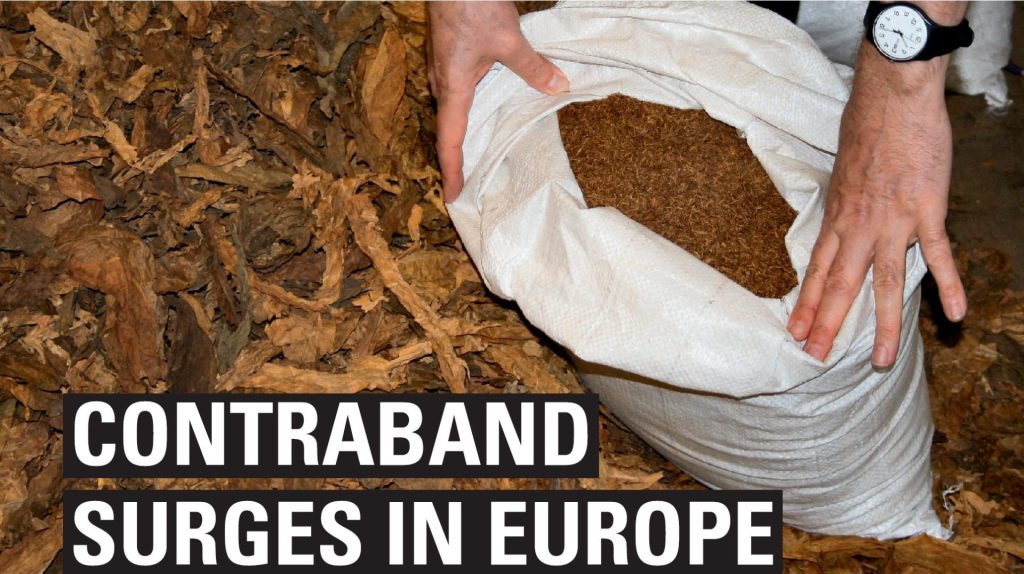
ENDS
THE APPROPRIATE CUSTOMS CLASSIFICATION IN THE WCO’S HARMONIZED SYSTEM TARIFF NOMENCLATURE OF TOBACCO HEATING PRODUCT CONSUMABLES AND THE CHEMICAL PREPARATIONS USED IN ENDS SUMMARY OF PROPOSED NEW HEADINGS AND SUB-HEADINGS FOR THE CLASSIFICATION OF THP CONSUMABLES AND CHEMICAL PREPARATIONS USED IN ENDS
• Tobacco Heating Products (THPs) heat tobacco, but do not combust it, to produce a nicotine-containing aerosol.
• Electronic nicotine delivery systems (ENDS) heat a chemical preparation (often, but not always, in liquid form, known as an ‘e-liquid’), to create an aerosol which is fundamentally different in its physical composition to both tobacco smoke and to the aerosol created by THPs. Although some chemicals in e-liquids, including nicotine and some soluble flavourings, may be derived from tobacco, e-liquids do not contain tobacco.
• The WCO’s Review Sub-Committee (RSC) is currently considering several proposals for creating new headings or subheadings for both THPs and e-liquids under the Harmonized System Tariff Nomenclature (the HS) in the year 2022. These proposals are flawed because they are inconsistent with the fundamental principle by which products are classified for customs purposes based on their essential physical characteristics.
• The Confederation of European Community Cigarette Manufacturers (CECCM) and its members1 propose that THPs should be classified in the HS under a new subheading 2403.92 as follows:
2403.92 Tobacco products for heated delivery without combustion
• CECCM proposes that the chemical preparations used with ENDS, including e-liquids, should be classified in the HS under a new 4-digit level heading 38.27:
38.27 Chemical preparations, whether or not containing nicotine or flavouring substances and whether or not contained in bottles or special cartridges or capsules, for use with electronic devices heating these preparations without combustion in order to produce an aerosol:
3827.10 – containing nicotine
3827.20 – not containing nicotine
• It would not be appropriate for the chemical preparations used with ENDS to be treated in the same way as THPs in regulation, excise or customs classification. THPs are tobacco products, whereas the chemical preparations used in ENDS contain no tobacco – they are fundamentally different in their essential physical composition.
• These proposed new headings / subheadings adhere to the fundamental principles by which products are classified for customs purposes based on their essential physical characteristics. They maintain simplicity within the existing system. And they will allow the WCO and its contracting parties to achieve all the stated objectives of the HS: to facilitate international trade; to facilitate the collection, comparison and analysis of trade statistics; and to promote the standardisation of trade documentation and the transmission of data.
1 CECCM represents the common views of major European–based cigarette manufacturers such as British American Tobacco (BAT), Imperial Brands (IMB), and Japan Tobacco International (JTI).
DEFINITION OF TOBACCO HEATING PRODUCTS AND ENDS
• Tobacco Heating Products (THPs) are products in which the tobacco is heated rather than combusted to produce a nicotine-containing aerosol.
o THPs contain tobacco – they are different to electronic cigarettes which do not contain tobacco.
o Several types of THP are currently sold across a range of countries. The most widely available THPs are electrically heated tobacco products. Also available in some countries are: THPs that heat a tobacco rod using a lit carbon tip; and hybrid products that heat an e-liquid to create an aerosol that, when passed over a tobacco pod, heats the tobacco to provide additional flavours and nicotine.
o The category is rapidly evolving, and it seems likely that other types THPs will be developed in the future. However, the common feature amongst all THPs will remain that they heat tobacco and do not combust it.
• Electronic nicotine delivery systems (ENDS) are comprised of two elements:
o First, a chemical preparation, often in liquid form known as an ‘e-liquid’. Although some chemicals in the chemical preparations used in ENDS, including nicotine and soluble flavourings, may be derived from tobacco, they do not contain tobacco.
o Second, an electronic device which heats the chemical preparation to create an aerosol which is fundamentally different in its physical composition to tobacco smoke. THE CURRENT CLASSIFICATION OF TOBACCO HEATING PRODUCTS AND THE CHEMICAL PREPARATIONS USED IN ENDS
• THP consumables, as a tobacco product, are classified in Chapter 24 of the HS (“Tobacco and Manufactured Tobacco Substitutes”). In October 2017, the WCO Harmonized System Committee (HSC) considered the appropriate classification of Electrically Heated Tobacco Product (EHTP) consumables in the 2017 HS. A large majority of contracting parties voted for classification of these products in subheading 2403.99.
• In September 2011, the HSC agreed that cartridges for ENDS “whether or not containing nicotine, could not be regarded as tobacco substitutes.” Consequently, it decided to classify them under heading 38.24 of the HS (in the chapter covering “Miscellaneous Chemical Products”). TOBACCO HEATING PRODUCTS MUST BE
CLASSIFIED IN CHAPTER 24 OF THE HS AND THE CHEMICAL PREPARATIONS USED IN ENDS MUST BE CLASSIFIED IN CHAPTER 38
• For customs classification, two criteria must be considered.
o First, the essential physical characteristics of the product.
o Second, in some cases, their intended use.
• The consumables used with tobacco heating products should continue to be classified under a subheading in 2403.9 of the HS nomenclature (under which there is currently 2403.912 or 2403.993).
o THPs contain tobacco, so it follows that they must be classified in Chapter 24 of the HS, covering “Tobacco and manufactured tobacco substitutes”.
2 “Homogenised” or “reconstituted tobacco”.
3 Other manufactured tobacco that is not intended for smoking.
o The WCO Secretariat has indicated that two factors are relevant to defining the essential characteristics of the consumables used with electrically heated tobacco products (EHTPs). First, the tobacco used in these products is entirely reconstituted tobacco (combustible tobacco products contain much smaller amounts of reconstituted tobacco). Second, the product’s intended use is not to be smoked. The WCO Secretariat stated that if Contracting Parties accept these as the defining essential physical characteristics of EHTP consumables, they should not be classified under the same subheadings as combustible tobacco (i.e. under either heading 24.024, or under subheadings 2403.115 or 2403.196, all of which are for types of smoking tobacco).
o Moreover, EHTPs cannot be classified under heading 24.01, which covers unmanufactured tobacco.
o It follows that EHTPs must be classified in the part of heading 24.03 that covers finished tobacco products that are not intended for smoking.
• The chemical preparations used in ENDS, including e-liquids, should continue to be classified under Chapter 38 of the HS nomenclature.
o The chemical preparations used in ENDS, including e-liquids, exhibit profound differences in their material composition and physical characteristics to the tobacco products that are classified under Chapter 24 of the HS2017.
o Since e-liquids (and other chemical preparations used in ENDS) are chemical solutions which, even when partly derived from a tobacco plant, contain no tobacco, they must continue to be classified in HS Chapter 38 (“Miscellaneous chemical products”).
o And because ENDS cartridges / liquids do not display similar physical characteristics to tobacco products, the chemical preparations used in ENDS should not be classified in the same chapter of the HS as tobacco products.
o Please see Appendix 1 for a legal opinion that provides further background.
PROPOSAL FOR NEW SUBHEADINGS FOR TOBACCO HEATING PRODUCT CONSUMABLES IN CHAPTER 24 OF THE HS IN THE YEAR 2022
• Our proposal for the customs classification of THP consumables in the HS is to create a new subheading 2403.92.
• This approach has several practical benefits:
o It is wholly consistent with the general principles by which products are classified in the HS according to their essential physical characteristics.
o It is consistent with the recent guidance from the WCO Secretariat regarding the essential characteristics of EHTP consumables.
o It is commensurate with the likely scale of global trade in THP consumables relative to other tobacco products. Notably, since cigarettes containing tobacco are classified under a subheading (2402.20) and do not have their own 4-digit heading, it would seem inappropriate for THPs to be classified under anything other than a 6-digit subheading.
• Our proposal for this new sub-heading is as follows:
2403.92 Tobacco products for heated delivery without combustion
• The wording of this proposed new sub-heading is similar to the recent proposal by the Australian customs authority. However, our proposed location in the HS – especially when taken together with our proposed new heading for the chemical preparations used with ENDS – is more logical given the general principles by which products are classified in the HS according to their essential physical characteristics.
4 Cigars, cheroots, cigarillos and cigarettes, of tobacco or of tobacco substitutes.
5 Water pipe tobacco.
6 Other smoking tobacco.
• Please see Appendix 2 for a legal opinion that provides further background.
PROPOSAL FOR A NEW HEADINGS FOR CHEMICAL PREPARATIONS USED WITH ENDS IN CHAPTER 38 OF THE HS IN THE YEAR 2022
• Our proposal for the customs classification in the HS of chemical preparations used with ENDS (including e-liquids) is to create, at the 4-digit level, a new heading 38.27.
• This approach has several practical benefits:
o It is wholly consistent with the general principles by which products are classified in the HS according to their essential physical characteristics. Unlike the recent proposals by Australia, it therefore avoids creating inconsistencies between the classification of ENDS chemical preparations and how other products are classified in the HS.
o It would make ENDS chemical preparations stand out within Chapter 38 more forcefully than by creating new subheadings under heading 3824.
o It would leave more room for future subheadings as and when new products are developed.
• Our proposal for the new heading / sub-headings is as follows:
38.27 Chemical preparations, whether or not containing nicotine or flavouring substances and whether or not contained in bottles or special cartridges or capsules, for use with electronic devices heating these preparations without combustion in order to produce an aerosol:
3827.10 – containing nicotine
3827.20 – not containing nicotine
• Please see Appendix 2 for a legal opinion that provides further background. OUR PROPOSALS FOR A NEW SUBHEADING FOR TOBACCO HEATING PRODUCTS AND A NEW HEADING FOR THE CHEMICAL PREPARATIONS USED WITH ENDS WILL ALLOW ALL THE STATED REQUIREMENTS OF THE HS TO BE MET IN FULL
• The three main objectives of the HS are to:
o facilitate international trade;
o facilitate the collection, comparison and analysis of trade statistics; and
o promote the standardisation of trade documentation and the transmission of data.
• The new headings and subheadings we propose for THPs and ENDS chemical preparations would allow each of these objectives to be met in full. Critically, moving the classification of e-liquids from Chapter 38 to another chapter of the HS would not fundamentally improve the ability of customs authorities to achieve any of these objectives. It would, however, be inconsistent with the fundamental principle by which products are classified for customs purposes based on their essential physical characteristics.
BRUSSELS: The Confederation of European Community Cigarette Manufacturers (CECCM) has today called on any European governments considering plain tobacco packaging to rethink their approach.
Speaking on the 1st anniversary of the French plain packaging law¹, Alisdair Gray, Secretary General of CECCM said: “Official sales of cigarettes in France have not shifted since the adoption of the law. Incredibly, France’s own Health Minister now publicly admits that plain packs do not stop smokers from smoking².

In France, where plain packaging has been in force since 1 January 2017, data published by the public authority OFDT³ indicates that tobacco products shipped to retailers have remained largely identical for the first nine months of 2017 (year on year).
Gray added: “The data clearly demonstrates that the introduction of plain packaging, even in combination with the EU Tobacco Products Directive, has failed to reduce sales of tobacco. In Australia, where the extreme measure has been in force for five years, the latest government data has shown a stall in the long-term downward trend in smoking, despite massive increases in excise.”
“The vast majority of EU countries are still unconvinced that plain packaging will work. Around a third of EU member states even raised concerns about the introduction of such pack changes when first proposed by the French government”.
It is high time for other governments to recognise that this form of heavy handed regulation simply does not work”.
ENDS
2 Assemblée Nationale Article 12
BRUSSELS: The Confederation of European Community Cigarette Manufacturers (CECCM), the largest tobacco industry Association in Europe, has today declared the plain packaging experiment for tobacco products a failure.
Speaking on the 5th anniversary of the Australian Tobacco Plain Packaging Act, Alisdair Gray, Secretary General of CECCM said: “There is no reliable or robust evidence that shows that plain packaging is contributing to improving public health. It has not reduced smoking prevalence or uptake by young people”.

“If anything, evidence shows that the main reasons for adolescents to smoke are sensation-seeking, peer and family-influence, not packaging¹.
In France, where plain packaging has been in force since 1 January 2017, data published by the public authority OFDT² indicates that tobacco products shipped to retailers have remained largely identical for the first nine months of 2017 (year on year).
Gray added: “The data clearly demonstrates that the introduction of plain packaging, even in combination with the Tobacco Products Directive, has failed to reduce sales of tobacco wherever it has been introduced”.
ENDS
¹ Attitudes of Europeans Towards Tobacco
BACKGROUND AND SUMMARY
• Australia’s Department of Immigration and Border Protection (Australia) has submitted a proposal to the Harmonized System Review Sub-Committee (RSC) of the World Customs Organization (WCO). Australia proposes amendments to Chapter 24 of the Harmonized Commodity Description
and Coding System (HS System), which currently consists of headings and sub-headings for the classification of “Tobacco and manufactured tobacco substitutes.”
• Australia proposes to amend Chapter 24 of the HS to create a new heading for inter alia chemicals that are tobacco-free, such as liquid solutions, with or without nicotine, for use with electronic nicotine delivery systems (ENDS).
• Chemical solutions for use with ENDS – i.e. so-called e-liquids – are chemical mixtures that generally contain nicotine1, propylene glycol, glycerin water, and soluble flavorings. As such, they are, and have consistently been, classified under Chapter 38 of the HS (Miscellaneous chemical products). This has been confirmed by classification opinions issued by the WCO and adopted by the Contracting Parties to the HS Convention, including the EU and the United States.
• Yet, Australia proposes to amend Chapter 24 of the HS to create a new heading for, inter alia, tobacco-free e-liquids.
• For the reasons explained in greater detail below, CECCM (Confederation of European Community Cigarette Manufacturers)2 do not support the creation of new headings under Chapter 24 of the HS for the classification of tobacco-free chemicals, such as e-liquids.
CHAPTER 24 OF THE HS SHOULD NOT BE AMENDED TO INCLUDE CHEMICALS
• E-liquids should continue to be classified under Chapter 38 of the HS nomenclature. For customs classification, two criteria must be considered. First, the essential physical characteristics of the product. Second, in some cases, their intended use. The composition and intended use of e-liquids render them significantly different to products currently classified in Chapter 24 of the HS (“Tobacco and manufactured tobacco substitutes”). In particular, e-liquids do not contain tobacco
and there is no combustion involved in their use. Since e-liquids are chemical solutions that do not contain tobacco, they must continue to be classified in HS Chapter 38 (“Miscellaneous chemical products”).
• The above approach is consistent with the practice of officials responsible for tariff classification issues. At its 48th Session in September 2011, the Harmonized System Committee (HSC) of the WCO adopted a classification opinion in which it decided that, due to their composition and use, cartridges for electronic cigarettes, “whether or not containing nicotine, could not be regarded as tobacco substitutes.”
• In addition, in November 2016, the EU’s Customs Code Committee agreed, with no dissenting voices, that cartridges and refills for so-called Electronic Nicotine Delivery Systems (ENDS) should be classified in Chapter 38 of the HS, and the devices for their use should be classified in Chapter 85 of the HS.
• In the United States, the Committee for Statistical Annotation of Tariff Schedules—comprising representatives from USITC, U.S. Customs and Border Protection (CBP), and the U.S. Census Bureau (Census) – established six new statistical reporting numbers for e-cigarette devices, parts, and liquid in the Harmonized Tariff Schedule of the United States. These reporting numbers took effect in 2016. The reporting numbers for e-cigarette devices and parts are placed under Chapter
85, while the reporting numbers for liquids are placed under Chapter 38.
• The inclusion of chemical solutions under the same Chapter of the HS system as tobacco containing products would lead to an obvious lack of physical commonality among these diverse products. Yet it is a well-established principle that classification under the HS nomenclature must clearly reflect the physical properties of a product.
THE OBJECTIVES OF THE HS NOMENCLATURE CAN BE MET IN FULL IF E-LIQUIDS CONTINUE TO BE CLASSIFIED UNDER HS CHAPTER 38
• The three main objectives of the HS are to: (i) facilitate international trade; (ii) facilitate the collection, comparison and analysis of international trade statistics; and (iii) promote the standardization of trade documentation and the transmission of data. Shifting the classification of e-liquids from Chapter 38 of the HS to Chapter 24 of the HS would not improve the ability of customs authorities to achieve any of these objectives.
• According to Australia, its proposal is motivated by a desire to “enable data collection on the trade” of nicotine products for human consumption. However, if Contracting Parties to the HS Convention are interested in improving the collection of statistics on the international trade of e-liquids, they can consider amending Chapter 38 of the HS system to create a new six-digit subheading specifically for e-liquids. Alternatively, individual countries can already achieve this objective
nationally and in full by creating new 8 or 10 digit subheadings in their national nomenclatures under existing HS code 3824.99. We note in this regard that the United States, for example, has specific 10 digit sub-headings for “e-cigarette liquid that contains 5 percent or more by weight of nicotine” (3824.90.2840) or “less than 5 percent by weight of nicotine” (3824.90.9280). Other WCO members could certainly adopt a similar approach.
CONCLUSION
• For the above reasons, CECCM (Confederation of European Community Cigarette Manufacturers) representing the common views of major European–based cigarette manufacturers such as British American Tobacco (BAT), Imperial Brands, and Japan Tobacco International (JTI) as well as 13 national Manufacturers’ Associations, do not support the creation of new headings under Chapter 24 of the HS for the classification of tobacco-free chemicals, such as e-liquids.
Tracking and tracing of tobacco products helps fight the illegal trade by identifying the point of diversion from the legal supply chain. To be efficient a track & trace system should allow the tracing of products across borders and therefore any legislation should only prescribe recognized international standards and ensure that global operators are free to choose their preferred system and suppliers. This will reduce costs and guarantee free competition while offering a state of the art tool for control by law enforcement agencies.
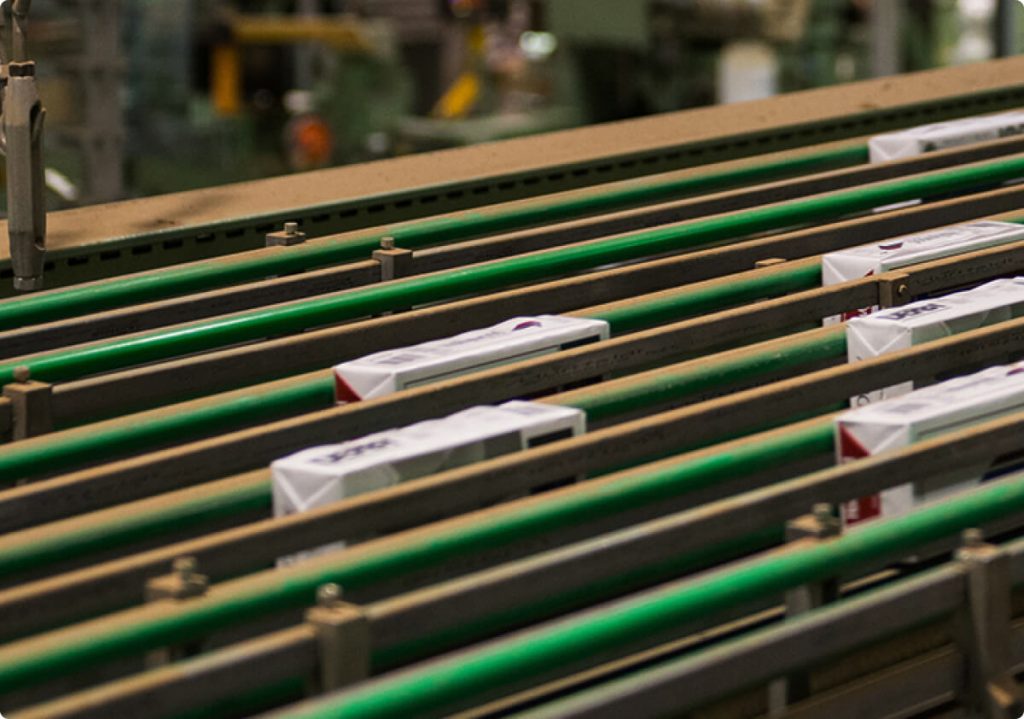
Brussels, June 19 2023
Find the full document here: Tobacco Europe Letter on Procedural Shortfalls Public Consultation